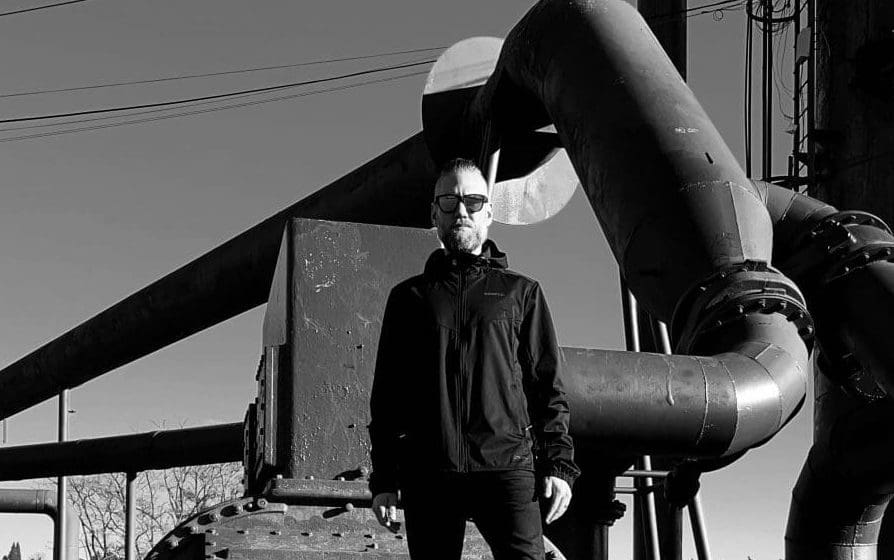Glis interview with Shaun Frandsen on industrial sounds and future pop fusion


Glis
Glis, the electronic music project founded by Shaun Frandsen in 2001, made an unexpected triumphant comeback with the release of the “Gateway To Oblivion” album, a manifestation of the artist’s DNA, blending the raw energy of industrial music with the infectious melodies of future pop. The new album was produced by Sebastian Komor and also features guest vocals by his good old friend AYRIA, and is a strong candidate to be the best future pop album of the year… We did not resist call Seattle for a chat with Shaun…
The album is out now as download and streaming, including from Bandcamp, and on CD, available via the Alfa Matrix webstore.
SL: “Gateway To Oblivion” marks your unexpected return after many years. What motivated you to revive GLIS, and what themes or messages did you want to convey with this new album?
S. It’s partly the 20-25 year anniversary syndrome. I was feeling like I should do something to commemorate the passing of time. The main spark was last summer during a family vacation in Mexico. I was drinking margaritas and talking to my brother-in-law (who’s also a musician in the folk rock scene) about how music is the language of the cosmos and how important it is to create new things. When I returned home I finished “Sunrise v3.0” and then started working on brand new music.
SL: The album blends industrial music with future pop, showcasing your versatility as a producer, vocalist, songwriter, and instrumentalist. Can you describe your creative process in developing such a diverse and spontaneous sound?
S. I feel like GLIS has always been a blend of different electronic sub-genres. Some albums more than others, but on this one I wanted to kind of showcase the overall aesthetic of the sound throughout the years. I feel you can get a reflection of each of the previous albums on this new album.
SL: Tracks like “Into the Flames” nod to influences such as NIN and DEPECHE MODE. How did these influences shape the mood and direction of “Gateway To Oblivion”?
S. Those are two bands that have been huge influences on me throughout the years (and both still making great music to this day). “Into the Flames” is a kind of intro track that I imagined would also be the intro to the live gig as well. Yes, we want to play live again too! I think you can definitely hear both NIN and DM influences in this track. A bit of “Songs of Faith and Devotion” and “The Fragile”…
SL: Songs like “Ascension” and “Mexico” evoke a straight-up early 2000s synth pop vibe. How do you balance nostalgic elements with contemporary sounds to create something fresh and relevant?
S. Well, I don’t tend hide my influences. “Ascension” is a straight up ode to ICON OF COIL. I met them in 2001 while supporting them in Seattle during their tour with VNV NATION. That’s when I first met Sebastian who helped produce this album and Andy who I worked with a lot in COMBICHRIST. Mexico” is simply supposed to invoke the party vacation vibe in Puerto Vallarta (Mexico). That’s where I decided I was going to bring back GLIS again. Sebastian Komor had a heavy hand in the production of that track. My original demo was more DEPECHE MODE sounding. He made it a lot groovier.
SL: “Cut Away the Demons” and “Damaged” dive into oppressive industrial noise and powerful EBM. What inspired these tracks, and how do they fit into the overall narrative of the album?
G. “Cut Away the Demons” is supposed to be a track that could have been on the “Nemesis” album. Its lyrics and cadence are inspired by Jean-Luc De Meyer’s vocal contribution to that album. It’s about someone who’s overcome by the darkness of addiction and their resolve to conquer it. “Damaged” is a kind of protest track and a musical nod to late 90’s electro-industrial bands such as :WUMPSCUT: and LEATHER STRIP. Two bands I listened to a lot back in the late 90s.
SL: The album features a unique guest appearance by Jennifer Parkin of AYRIA on “Dream Chaser.” How did this collaboration come about, and what was it like working together again?
G. Jenn and I have always kept in touch throughout the years after I produced her first album. We had an amazing time touring together. We even brought her along when I was in COMBICHRIST. We’ve always tried to catch up when she came to town with AYRIA. Last time she was here (in Seattle) in October I told her I was making new music and she said she would love to collaborate again. It was like old times. A full circle moment as she contributed guest vocals on one of my first releases in 2003, which turned into the first AYRIA album soon after.
SL: Like you mentioned it, Sebastian Komor played a pivotal role in shaping the album’s sound. How did his involvement influence the final production, and what elements did he bring to the table?
S. Sebastian went above and beyond what I thought was going to happen when I gave him my original versions of the tracks. He created sounds that we’re begging to evolve from the music. He added a lot of beat elements as well as melodic harmonies. I can’t tell you how happy I am with his work on this album. He took a lot of my tracks and completely boosted their sound quality. He’s a great producer.
SL: “Gateway To Oblivion” tackles themes around the ascension of mankind and the challenges posed by technology. Can you elaborate on these themes and how they reflect both personal and societal struggles?
S. I mean we can all see it happening before us each day. This merging of technologies with everyday life. We’ve basically become part machine by always having smartphones with us everywhere we go. And with the recent emergence of A.I. we’re facing all new challenges and problems as musicians. We’re at the point where we can choose to embrace it all or find some reason to hold back. Will we soon have to validate the fact that we’re human? We seem to be at another turning point in our existence and that’s the overall theme of “Gateway to Oblivion.” It’s a theme commonly addressed on the Industrial music genre, but more than ever it seems these days. We’re moving close to big changes. Are they all for the greater good? We’ll take a dive in and see.
Since you’re here …
… we have a small favour to ask. More people are reading Side-Line Magazine than ever but advertising revenues across the media are falling fast. Unlike many news organisations, we haven’t put up a paywall – we want to keep our journalism as open as we can - and we refuse to add annoying advertising. So you can see why we need to ask for your help.
Side-Line’s independent journalism takes a lot of time, money and hard work to produce. But we do it because we want to push the artists we like and who are equally fighting to survive.
If everyone who reads our reporting, who likes it, helps fund it, our future would be much more secure. For as little as 5 US$, you can support Side-Line Magazine – and it only takes a minute. Thank you.
The donations are safely powered by Paypal.








